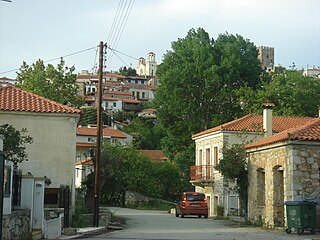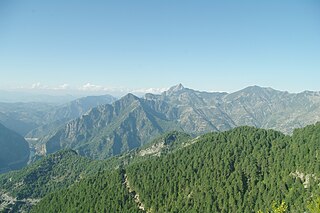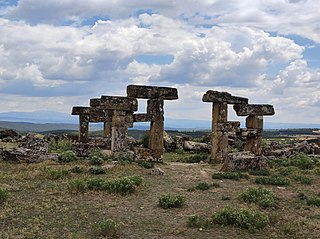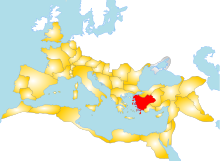
Tripolis on the Meander – also Neapolis, Apollonia, and Antoniopolis – was an ancient city on the borders of Phrygia, Caria and Lydia, on the northern bank of the upper course of the Maeander, and on the road leading from Sardes by Philadelphia to Laodicea ad Lycum. It was situated 20 km to the northwest of Hierapolis.
Savatra, Sabatra, or Soatra was a city in the Roman province of Galatia, and subsequently the Byzantine province of Lycaonia.
Loryma was an ancient town and episcopal see of ancient Caria, in Asia Minor. It is now listed as a titular see. Loryma was a fortified place with a port, close to Cape Cynossema, on the westernmost point of the Rhodian Chersonesus, in Caria. Its harbour was about 20 Roman miles distant from Rhodes and was belonging to the Rhodians. Strabo applies the name Loryma to the whole of the rocky district, without mentioning the town. The Larumna of Pomponius Mela and the Lorimna of the Tabula Peutingeriana perhaps refer to Loryma, although it is also possible that they may be identical with a place called Larymna mentioned by Pliny in the same district.

Avlonari is a village and a community (unit) of the Municipality Kymi-Aliveri, in the eastern part of the Aegean island of Euboea, Greece. It was the seat of the municipality of Avlon, and the medieval town and bishopric of Aulon, which remains a Latin Catholic titular see.
Zaliche or Zaliches (Ζαλίχης) was an ancient town in the late Roman province of Helenopontus.
Cestrus was a city in the Roman province of Isauria, in Asia Minor. Its placing within Isauria is given by Hierocles, Georgius Cyprius, and Parthey's. While recognizing what the ancient sources said, Le Quien supposed that the town, whose site has not been identified, took its name from the River Cestros and was thus in Pamphylia. Following Lequien's hypothesis, the 19th-century annual publication Gerarchia cattolica identified the town with "Ak-Sou", which Sophrone Pétridès called an odd mistake, since this is the name of the River Cestros, not of a city.
Temnos or Temnus was a small Greek polis (city-state) of ancient Aeolis, later incorporated in the Roman province of Asia, on the western coast of Anatolia. Its bishopric was a suffragan of Ephesus, the capital and metropolitan see of the province, and is included in the Catholic Church's list of titular sees.

Irenopolis or Eirenopolis or Eirenoupolis was an ancient Roman, Byzantine and medieval city in northeastern Cilicia, not far from the Calycadnus river, also known briefly as Neronias in honour of the Roman emperor Nero. Irenopolis was also an episcopal see that is now included in the Catholic Church's list of titular sees.

Mastaura, was an ancient Greek town near Dereağzı, Nazilli in northern Caria, not to be confused with ancient Mastaura (Lycia).

The Diocese of Laodicea in Phrygia, is an important Titular Christian Diocese, centered on the biblical city of Laodicea on the Lycus in modern Turkey. The Church at Laodicea was a centre of Christianity from a very early point. The New Testament indicates a Christian presence in Laodicea as early as the AD 50s. The church is mentioned extensively in the epistle to the Colossians, and the First Epistle to Timothy may have been written here. Further, the church was one of the Seven churches of Asia. A bishop was appointed in Apostolic Times, with numerous suffragean bishop attached.
Eudocia was a town in ancient Lycia.

Pella in Palaestina is an ancient and titular diocese of the Roman Catholic Church also called the Diocese of Khirbet El-wahadneh, and it is centered on Pella, Jordan.

Blaundus was a Greek city founded during the Hellenistic period in Asia Minor, presently Anatolia, and is now a Latin Catholic titular bishopric.
The Diocese of Derbe is an ancient bishopric located at Derbe in the Roman province of Galatia in Asia Minor, and in the ethnic region of Lycaonia. It flourished through the Roman and Byzantine empires, being dissolved on the invasion of the Seljuks at the Battle of Manzikert in 1071. The diocese was nominally refounded as a titular see of the Roman Catholic Church in the 17th century, although the area had never actually been catholic in profession.

Justinianopolis in Armenia also known as Iustinianopolis was a Roman and Byzantine era city and bishopric in Lesser Armenia. It has been identified with modern Sivrihisar, Eskişehir Province Central Anatolia, Turkey. It was one of several ancient sites renamed in late Antiquity after Byzantine emperor Justinian I. The city also known as Acilisene and Keltzene.
The Metropolis of Iconium is a metropolitan bishopric of the Ecumenical Patriarchate of Constantinople located at Iconium in Asia Minor, in the region of Lycaonia. It flourished through the Roman and Byzantine empires, and survived into the Ottoman Empire until the early 20th century and the Greco-Turkish population exchange, which led to the disappearance of the local Christian population.
Aspona was an ancient city and bishopric in Galatia, in central Asia Minor. It corresponds to the modern settlement of Sarıhüyük.
Vasada was a city of ancient Lycaonia and later of Isauria, Asia Minor. It was located a little to the southwest of Laodiceia. In the acta of church councils attended by its bishop, the name appears variously as Usada or Ousada (Οὔσαδα) or Aasada (Ἀάσαδα).

Cinna or Kinna was a town of ancient Galatia. It was known as Zallara in the Hittite period. It was also the seat of a bishop; no longer a residential see, it remains a titular see of the Roman Catholic Church.
Homana, also known as Homona and Homonanda, was a town of ancient Pisidia and later of Isauria and Lycaonia, inhabited in Hellenistic and Roman times. Pliny the Elder puts the town in Pisidia. It appears in the Synecdemus as part of Lycaonia under the name Umanada or Oumanada. It was the capital of the Homanadeis (Ὁμαναδεῖς), who, besides Homana, are said by Tacitus to have possessed 44 forts, a statement opposed to the remarks of Strabo, according to which the Homanades, the most barbarous of all Pisidian tribes, dwelt on the northern slope of the highest mountains without any towns or villages, living only in caves. In the reign of Augustus, the consul Quirinius compelled this little tribe, by famine, to surrender, and distributed 4000 of them as colonists among the neighbouring towns. It became a bishopric; no longer the seat of a residential bishop, it remains, under the name of Homona, a titular see of the Catholic Church.









